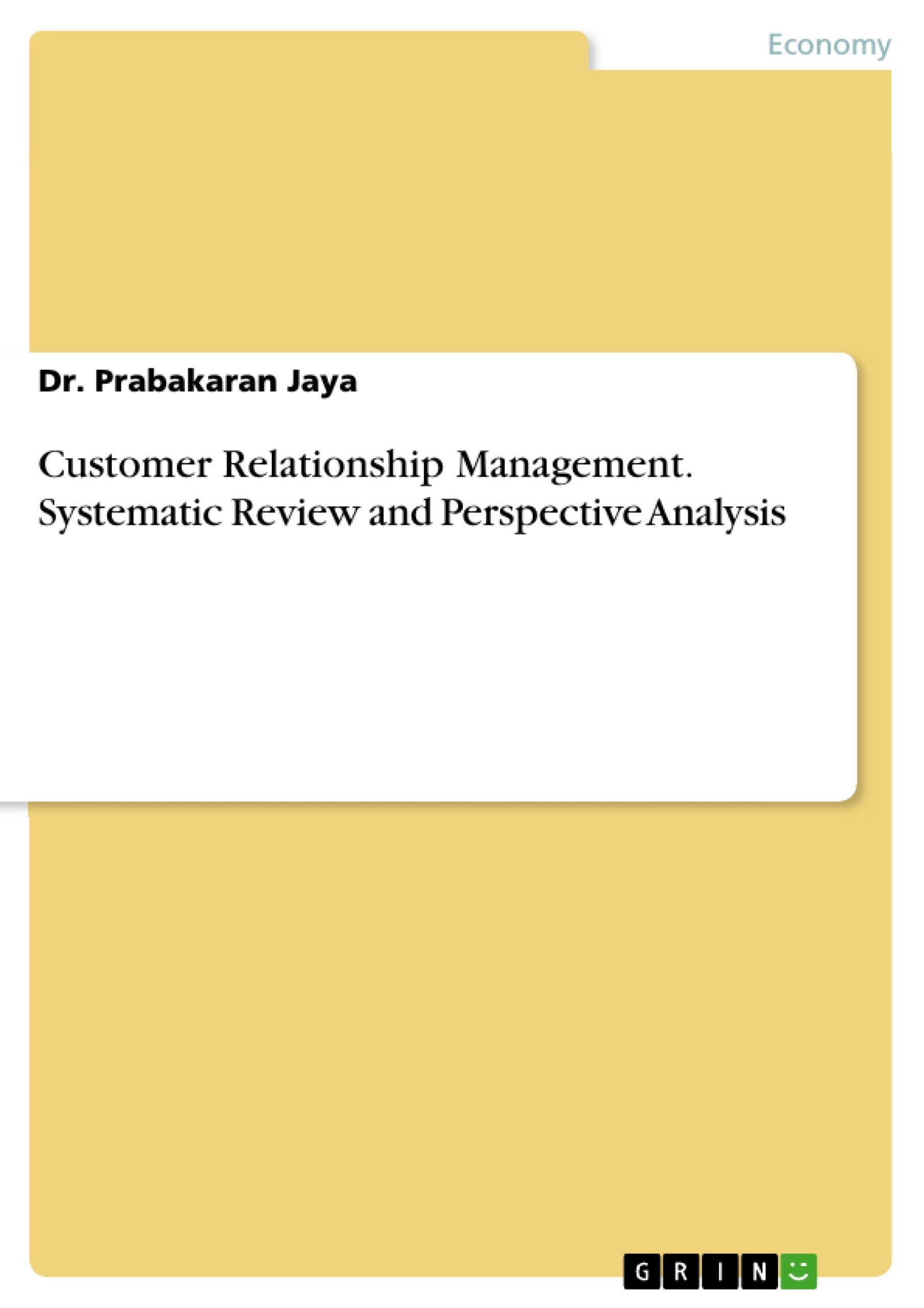This scientific paper deals with Customer Relationship Management (CRM) and gives a systematic review and perspective analysis.
Customer Relationship Management (CRM) is a way of thinking that guides the association to construct its cycles around its customer needs. An organization's ability to set up, keep up, and oversee favored associations with outer entertainers is considered as its upper hand. Furthermore, with an increment in volume of clients and rivalry in the worldwide market CRM has become universally perceived and right around an inescapable business practice.
Tuning in to clients and seeing their point of view, offering astounding help, having IT introduced to ensure that the assistance technique occurs, redressing botches, creating camaraderie and so on, are a few objectives that lead to progress. Separating administrations as per various clients is additionally significant. Furthermore, with regards to banking client is the center part in financial business.
The matter of banking can't work without clients, nor is the business done by obtaining certain number of clients. It is a persistent interaction of exchanges finishing in a drawn out financier client relationship.
Inhaltsverzeichnis (Table of Contents)
- Introduction
- CRM Principles
- CRM Exercises
- Advantages of CRM
- Needs of CRM
- CRM Drive and Revenue
- Key Challenges in Implementing CRM and Solutions
- Architecture of CRM
- Analytical CRM
- Purposes of CRM
- CRM in Banking Sector
- Banking- CRM Makes the difference
- CRM Mechanism for Banking
- CRM-Edge out Competition
- Customer Relationship, What and How?
- CRM and Business Banking
- Implementing CRM in Global Banks
- Contributions vs. Client Classification
- Successful Implementation of CRM
- CRM benefits and Strategies
Zielsetzung und Themenschwerpunkte (Objectives and Key Themes)
This work examines the significance of Customer Relationship Management (CRM) in today's competitive business environment, with a particular focus on its application in the banking sector. The study aims to analyze current CRM practices in banks, identify the status of the customer-bank relationship, and propose actionable strategies for implementing effective CRM solutions.
- The importance of CRM in a competitive global market
- CRM practices and strategies in the banking sector
- The relationship between banks and their customers
- Challenges and solutions for implementing CRM in banking
- The role of technology in facilitating CRM
Zusammenfassung der Kapitel (Chapter Summaries)
- Introduction: This chapter defines CRM as a customer-centric approach to business, emphasizing the importance of building long-term relationships for mutual benefit. It explores the core principles of CRM and discusses the role of technology in capturing and analyzing customer data.
- CRM Principles: This chapter delves deeper into the fundamental principles of CRM, emphasizing the importance of understanding customer needs and wants, offering exceptional customer service, and building trust and loyalty.
- CRM Exercises: This chapter provides practical exercises and examples that illustrate how CRM principles can be applied in different business contexts.
- Advantages of CRM: This chapter outlines the numerous benefits of implementing CRM, including increased customer satisfaction, improved customer retention, and enhanced profitability.
- Needs of CRM: This chapter explores the specific needs and challenges that necessitate the adoption of CRM, particularly in the context of rapidly evolving market dynamics and customer expectations.
- CRM Drive and Revenue: This chapter examines the direct correlation between CRM implementation and revenue growth, demonstrating how effective CRM strategies can drive sustainable business success.
- Key Challenges in Implementing CRM and Solutions: This chapter identifies common challenges faced during CRM implementation and proposes practical solutions to overcome them.
- Architecture of CRM: This chapter explores the different architectural components and technologies that underpin a successful CRM system.
- Analytical CRM: This chapter focuses on the analytical capabilities of CRM systems, demonstrating how data analysis can be used to gain valuable insights into customer behavior and preferences.
- Purposes of CRM: This chapter explores the various purposes and applications of CRM across different industries and business functions.
- CRM in Banking Sector: This chapter specifically examines the application of CRM principles in the banking industry, highlighting the unique challenges and opportunities presented by this sector.
- Banking- CRM Makes the difference: This chapter explores how CRM can differentiate banks in a highly competitive marketplace, emphasizing the importance of providing personalized and exceptional customer experiences.
- CRM Mechanism for Banking: This chapter outlines the specific CRM mechanisms and strategies that are particularly relevant for the banking sector, such as customer segmentation, relationship management, and tailored product offerings.
- CRM-Edge out Competition: This chapter examines the competitive advantages that banks can gain by effectively implementing CRM, emphasizing the importance of understanding customer needs and exceeding their expectations.
- Customer Relationship, What and How?: This chapter provides a comprehensive overview of customer relationship management in the banking sector, exploring the "what" and "how" of building successful customer relationships.
- CRM and Business Banking: This chapter explores the specific challenges and opportunities of applying CRM principles to business banking, highlighting the importance of tailoring solutions to the unique needs of corporate clients.
- Implementing CRM in Global Banks: This chapter examines the global context of CRM implementation, addressing the complexities of adapting CRM strategies to diverse cultural and regulatory environments.
- Contributions vs. Client Classification: This chapter discusses the importance of aligning CRM strategies with client classification, ensuring that the right resources and attention are allocated to different customer segments.
- Successful Implementation of CRM: This chapter explores the key factors that contribute to successful CRM implementation, emphasizing the importance of leadership commitment, stakeholder engagement, and a clear vision for the desired customer experience.
- CRM benefits and Strategies: This chapter summarizes the key benefits of CRM and outlines specific strategies for maximizing its impact on business performance.
Schlüsselwörter (Keywords)
Key concepts explored in this work include Customer Relationship Management (CRM), customer segmentation, customer retention, customer loyalty, data analysis, technology, banking, financial services, customer experience, competitive advantage, and strategic implementation.
- Citar trabajo
- Dr. Prabakaran Jaya (Autor), 2021, Customer Relationship Management. Systematic Review and Perspective Analysis, Múnich, GRIN Verlag, https://www.grin.com/document/1014342




